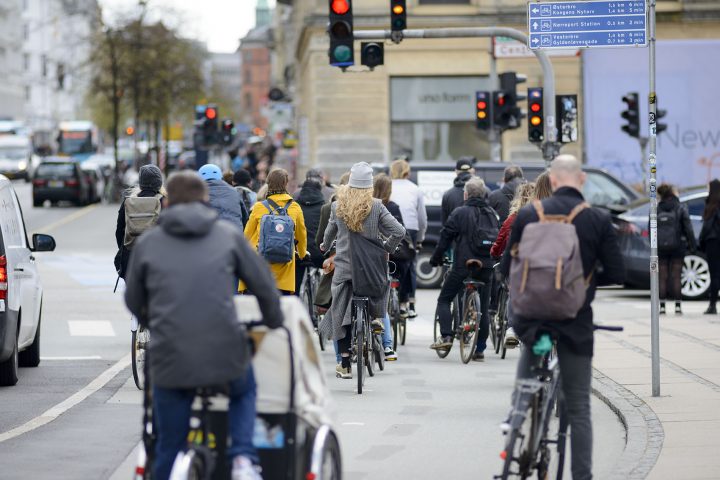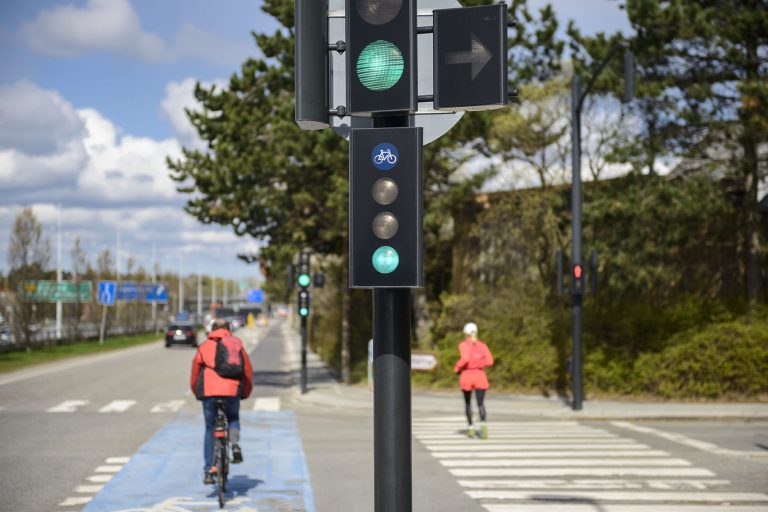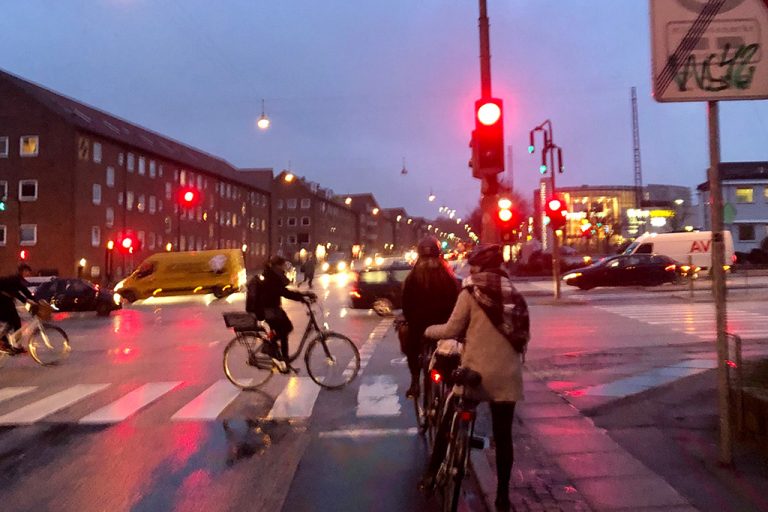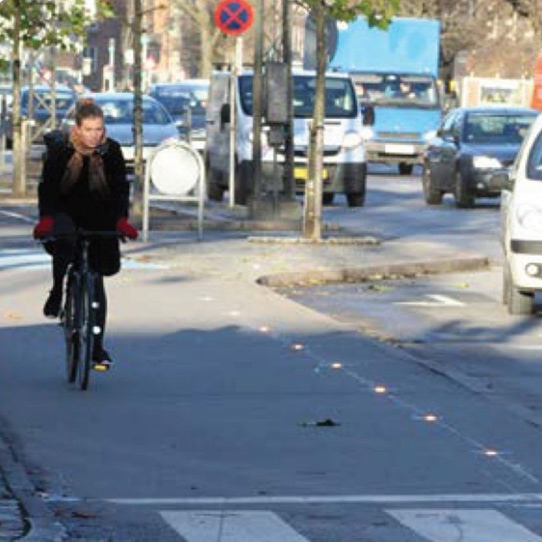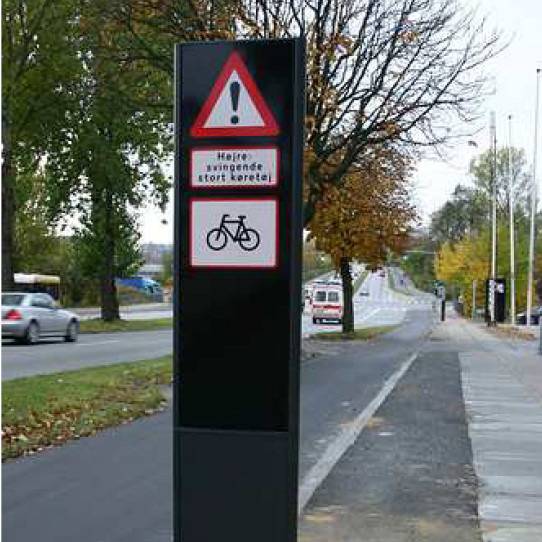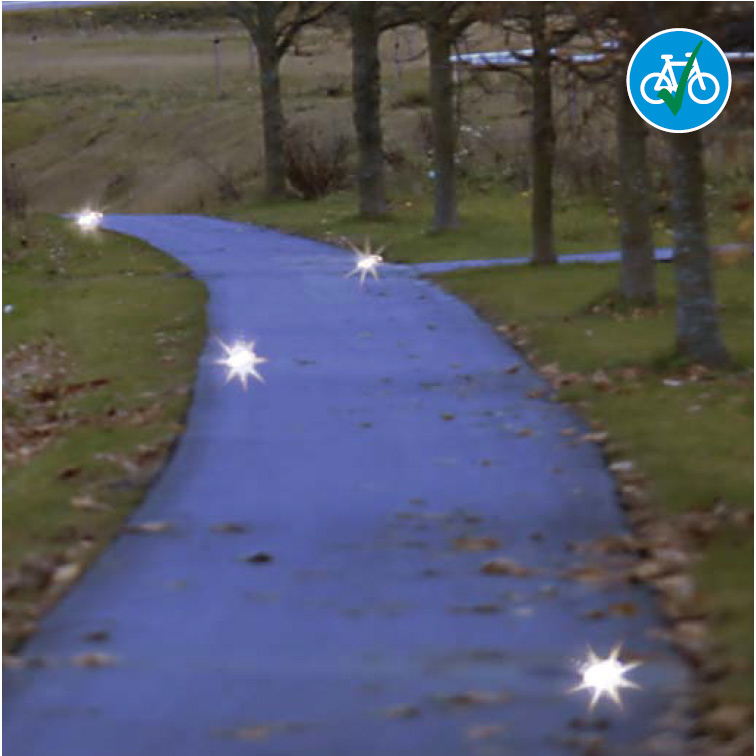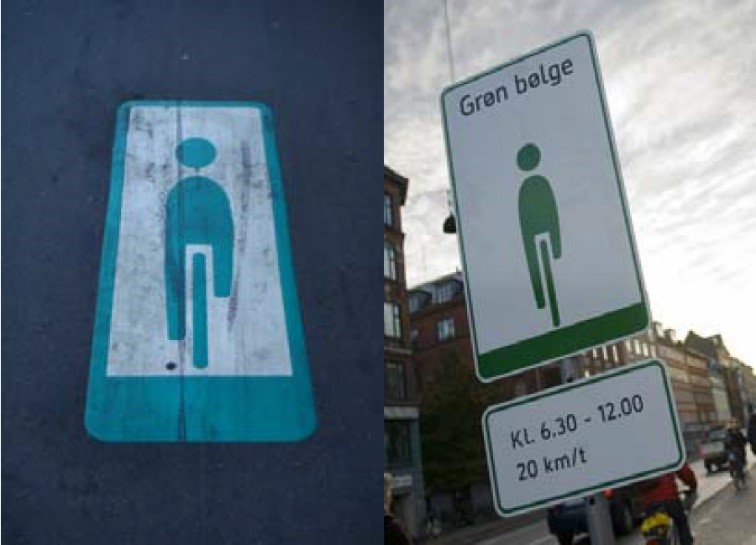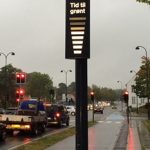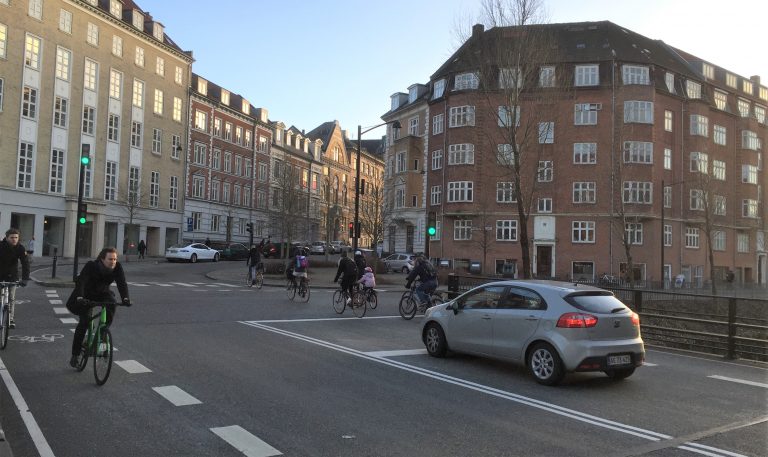ITS solutions for cyclists
For decades ITS has been primarily concerned with optimizing traffic flows and capacity and reducing travel times for motor traffic. However, over the past 20 years planners have begun using ITS solutions to improve cyclist accessibility, flows, and safety in traffic as well. New technologies and innovation as well as increasing demand mean that new solutions are constantly being developed and the field is undergoing rapid development.
By Marianne Weinreich and Maja Sig Vestergaard, Rambøll
Our cities have been affected by urbanization in a number of ways. Over the past 10 years cities have been experiencing increasing issues with congestion, air pollution, CO2 emissions, and noise as a result of urban planningduring the 1950s and 60sbased on motor traffic.
What is ITS?
Definition of ITS:
”All systems based on information technology and used in vehicles and infrastructure with the purpose of ensuring good mobility, accessibility, traffic safety, road user service, and more environmentally friendly transport.”
Source: Aarhus municipality
The bicycle is part of the solution to all of these major issues. For many years establishing a safe cycling infrastructure, educational campaigns, etc. were the standard way of motivating more people to cycle. In recent years, however, planners have begun using ITS solutions to make it easier and faster to get around by bike and to move more cyclists per hour.
For decades traffic controlled signals have been used to ensure better accessibility and the prioritization of motor vehicles, but planners are now increasingly focusing on how ITS can make cycling more attractive. In addition, new technology is enabling us todetect greater numbers of cyclists.
Before embarking on heavy investment in ITS solutions, planners should have a clear idea of exactly what it is that they wish the solution to achieve:
- Greater traffic safety for cyclists
- Better accessibility and comfort for cyclists
- Making bicycle traffic visible
The examples below show how different ITS solutions help fulfill the different aims.
Greater traffic safety for cyclists
Ensuring cyclist traffic safety is crucial. Different types of ITS solutions can be extremely helpful here.
Dedicated traffic lights for cyclists
In Denmark today cyclists have their own signal light at most large intersections with a cycle track.The light is often smaller than the main signal, and has a bicycle symbol.
- Photo: Cycle superhighways, capital region of Denmark.
- Riggade intersection, Aarhus, Photo: Marianne Weinreich
A special signal for cyclists makes it possible to prioritize and increase cyclist safety at intersections.

- Illustration of pre-green for cyclists, Danish Road Directorate
Giving cyclists a green light before cars, busses and trucks,means cyclists can enter the intersection first and are thus more visible to motorized road users.
Another option is giving cyclists a red light before motor traffic. This increases cyclist safety too since cyclists cross the intersection before motor vehicles and cyclists from side roads get the green light. However, the cyclist green phase is reduced and thereby their joy of cycling.
Prevention of right- turn accidents
Right- turn accidents unfortunately often have serious consequences for the cyclist, when cyclists going straight ahead collide with right- turning motor vehicles, particularly lorries, as it’s difficult for the driver to see the cyclist. Different ITS solutions have been implemented to forestall this type of accident, warning the driver that there is a cyclist on the cycle track:
LED sensors against right- turn accidents
The system has been tested in Copenhagen. Road studs are activated by cyclists when they ride ahead on green and light up the lorry driver’s side mirror so the lorry driver becomes more aware of the cyclists. Before -and -after studies were carried out of cyclist and lorry driver’sbehaviours. In three out of four intersections the number of conflicts was reduced by half. Both the cyclists and the drivers gave the system a positive response. The solution requires dispensation by the Danish Road Directorate.
- LED road studsincrease driver awareness that there are cyclists on the cycle track. Copenhagen.Photo: ITS-teknik
- Dynamic, variable signalinforms the cyclist that there is a large, right- turning vehicle on the road so the cyclist can act accordingly. Aarhus.Photo.Aarhus municipality.
Dynamic/variable signals against right- turn accidents
Aarhus has carried out pilot studies of dynamic signals at intersections. The signal is activated and informs the cyclist that there is a large motor vehicle in the right- turn lane. In this case it’s the cyclist that receives the warning in contrast to the system described above where the motorist/ lorry driver gets the warning.
The variable signals were assessed by behavioural studies using video registration and interviews. The number of conflict situations was reduced by 28% and cyclists look both ways more frequently than previously. Cyclists are generally satisfied with the signals: 86% prefer crossing the intersection with signals rather than without.
However, one conclusion is that some road users are confused by the signal so road users need to be better informed of the measure’s function. There have also been operational issues. A prerequisite for recommending the system is that it must be extremely reliable (so road users are not given incorrect information if it breaks down.) The solution requires dispensation from the Danish Road Directorate.
Lights and security
LED diodes in the track
Cycle tracks in areas with no street lighting can make cyclists feel insecure and may even be unsafe. Maximum traffic safety is achieved by lighting up the cycle track. However, this is a costly affair and several Danish local authorities have laid down LED diodes in the asphalt as an alternative for less than 10% of the cost of traditional lighting.
LED lights go on automatically when it gets dark and guide the cyclist on unlighted, winding paths. The cyclist feels more secure and can cycle faster since the cycle track up ahead is indicatedby the LED lights. Three different types were tested in Odense, but none were satisfactory due to operational instability.
SuperZOOkelsti
Egedal municipality has installed a special cycle track which both enhances security and motivates local school children to bike to school and remember their bike helmets. The so-called SuperZOOkelsti is 2.3 km long and takes the cyclist past 9 different animals up to 2.2 tall, which light up in different colors. All the cyclist needs to activate the chip on the SuperZOOkelstien’s website is a special chip in a bike helmet. The cyclist can choose between six different light shows and you can also program your own light show.
The project has been generally well received. Since it was launched in May2018 Egedal municipality has delivered almost 1,000 chips and has observed that the level of activity on the cycle track appears to have doubled.
- Guide lights (here CO2 neutral solar cells) can show the cyclist the cycle track route ahead. Photo: Danish Cyclists’ Federation/Cells Consult
- On the SuperZOOkelstien, Egedal municipality. Photo: Egedal municipality
Security in tunnels
The lighting concept was inspired by the bicycle wheel as a single, easily identifiable graphic element. Lighting circles were installed on the tunnel walls. The light wheels begin to rotate in the same direction as the passing cyclist. This creates a feeling of propulsion and flow. The wheel’s lighting movements gradually die down leaving an “echo” of former activity and presence until the next cyclist passes. The decorativelight wheels serve to enhance security by making user activity visible long after a cyclist has passed through the tunnel. For further information on the project click here (PDF).
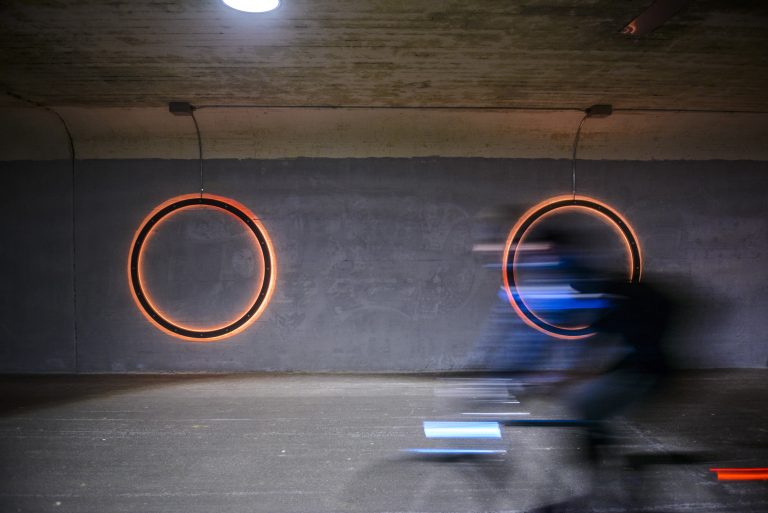
- Tunnel lighting on the Farum route. Photo: Cycle Superhighways, capital region of Denmark
In 2019 Odense municipality established the same solution on the Cycle Superhighway to SDU, University of Southern Denmark.
Better accessibility and comfort for cyclists
A major source of annoyance for cyclists is when there are many stops and when traffic signals prioritize driver accessibility rather than cyclists. It makes cyclists feel they have a low traffic priority.
Green waves where cyclists experience uninterrupted green lights at traffic signals can be installed in two general ways:
- Green wave with speed adaptationwhere the cyclist is helped adapt cycling speed to the signals to ride a green wave.
- Green wave with signal adaptation where the signals adapt to the cyclist’s speed instead.
Green wave with speed adaptation
The experience of a green wave can be created by helping cyclists maintain the correct speed in order reach the green light. Many cyclists don’t know whether they are riding atprecisely 18 or 20 km /h, which is necessary to create a green wave. Cyclists need to be shown how fast they should go. This can be done in various ways:
Lanelights
Lanelights were invented by Odense Cycle City when they were implemented to help cyclists achieve a more even riding rhythm by adapting their speed to the signal systemto be able to cross on green.
The lanelights were set up between two intersections and consisted of a total of 45 small bollards with diodes, 8 meters apart. By adapting their own speed to the speed indicated by the bollard lights (15 km/h) the cyclist could make the green light.
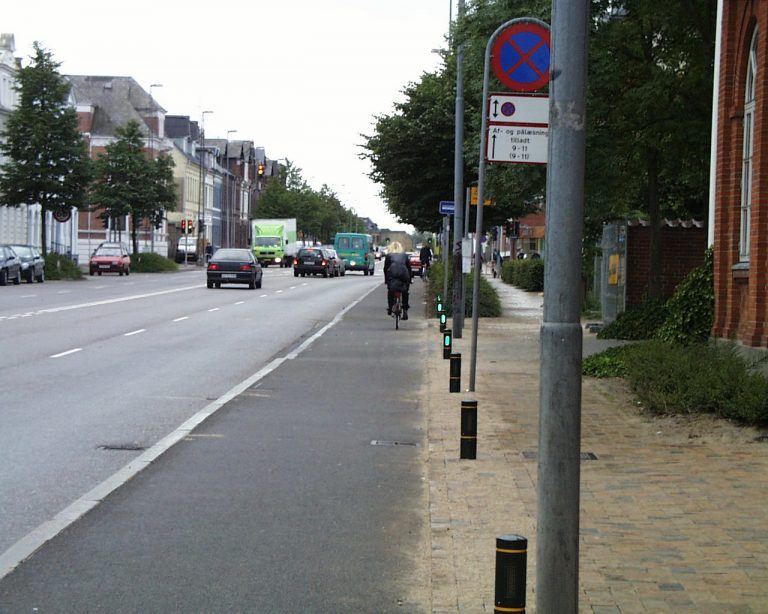
- The green wave is achieved by following the speed indicated by the lanelights, Odense Cycle City, 2001. Photo: Odense municipality
Vejle municipality installed lanelights on Grejsdalsvej in 2017. The purpose of the lanelights is to spoil cyclists by making cycling more fun and more effective. Green lights embedded in the cycle track light up as the count-down reaches green. The cyclist adapts speed to the lanelightand can cross on green.
Your speed – green wave
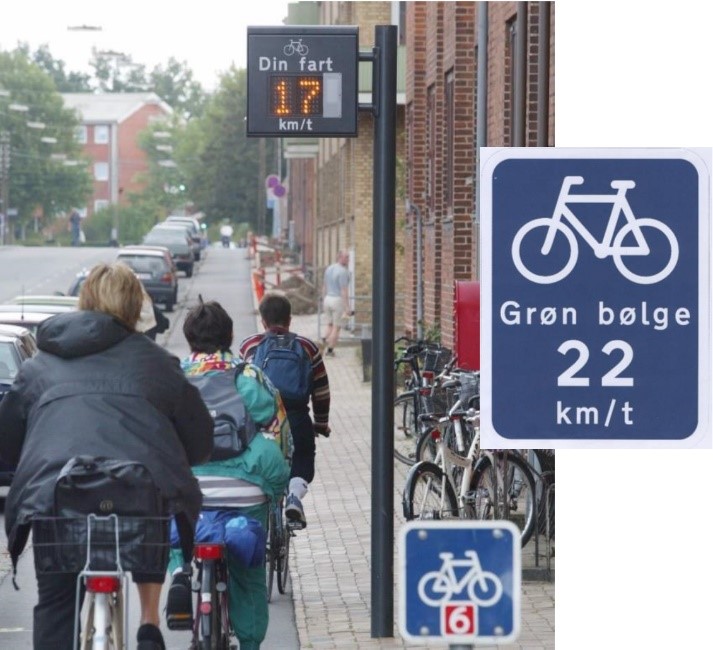
- Dynamic speed signs show cyclists their speed so they can adapt their speed to the signals. Photo: Odense municipality
Odense municipality introduced a green wave in 2002 in connection with the Odense Cycle City project. The green wave ran through four intersections on a commuter route and the speed was 22 km/h. “Your speed” signs showed cyclists how fast they were cycling so they could adjust their speed accordingly and catch the green wave.
In 2004 Copenhagen established a green wave on Nørrebrogade consisting of 13 signal intersections and a speed of 20 km/h. The green wave on Nørebrogadewas established by adjusting the existing signals which were already linked for motor traffic. The signals were prioritized for cyclists entering the city center in the morning and leaving the city center in the afternoon so the maximum number of cyclists experienced improved accessibility.
After the green wave was established average cycling speed was 20.3 km/h compared to 15.5 km/h previously. Other traffic (cars and busses) were only affected to a limited extent.
- Nørrebrogade, Copenhagen signs and pictograms make cyclists aware of the green wave. The wave is dimensioned to 20 km/h with changing priorities over the course of the day.
- Cycling speed on Nørrebrogade before and after the green wave was established in 2004. Source: City of Copenhagen, Center for Trafik, 2007
It is basically impossible to establish a green wave for cyclists on a given street in both directions at once. As with motor traffic, it is equally impossible to establish green waves for bicycle traffic crisscrossing the city. Consequently priorities must be worked out as to who should be given optimal accessibility and when. Cyclist detection can help ensure optimal accessibility for the greatest number of cyclists.
Count-down to signal change
The Cycle Superhighways Secretariat has made several studies of count-down signals intended to help cyclists adapt their speed to the signalization system and forestall annoying stops.
The way the system works in practice is that the cyclist can see graphically how much time is left before the light turns green. The lights are not able to show the precise number of seconds remaining since intersections are often traffic controlled, continuously adapting to the amount of motor traffic, which makes it difficult to tell cyclists precisely how many seconds are left.
The first generation is in the form of a vertical column while the second generation has a circle with smaller diodes, which will hopefully mean fewer “hops” and a softer flow even with changes in motor traffic.
The count-down systems were assessed, and given a mixed response by cyclists. For further information click here.
First and second generation count-down signals to green tested on the Allerød route in Copenhagen to a mixed reception. Photos: Cycle superhighways, capital region of Denmark
RFID chips
RFID chips (Radio Frequency Identification) are another option for optimizing cyclist accessibility. This requires either that the chip is on the cyclist or attached to the bicycle. The chip gives the individual cyclist a unique identity making it possible to break down data on the individual level and follow the cyclist moving through the city. RFID chips can be used in many ways:
- RFID scanners that register the chips can be installed at intersections, and the cyclist may then be given priority at the intersection.
- Registration of travel time by means of RFID chips will prove useful for identifying projects to promote cycling. Travel time data can be communicated to cyclists on the roadso they can choose the optimal route.
- RFID chips may also be used for campaign purposes where the RFID- chip user can be given certain advantages through various programs (for example free bicycle parking or free bus rides on rainy days), or contests can be arranged.
Aarhus municipality uses RFID technology at the Christiansgade/Grønnegade/Åboulevarden intersection where cyclists are given priority at the signalized intersection via RFID chips. Initially 200 cyclists were given a chip and they now experience the green light more often since they are detected approx. 100 meters before the intersection.
The white box detects the RFID chip on the bicycle when it passes and sends the message to the signal further along that a cyclist is on the way. Photo. Marianne Weinreich
Longer green phase for cyclists in rainy weather
Odense was the first city in the North to set up a rain sensor at an intersection, at Rødegårdsvej/Østerbæksvej. The sensor registers whether it’s raining,and two radars register whether cyclistsare on the way. If cyclists have defied the rain, they are rewarded with a double length green phase at the intersection. This is a pilot project but if it proves successful, cyclists on other stretches in Odense can look forward to longer green phases on rainy days.
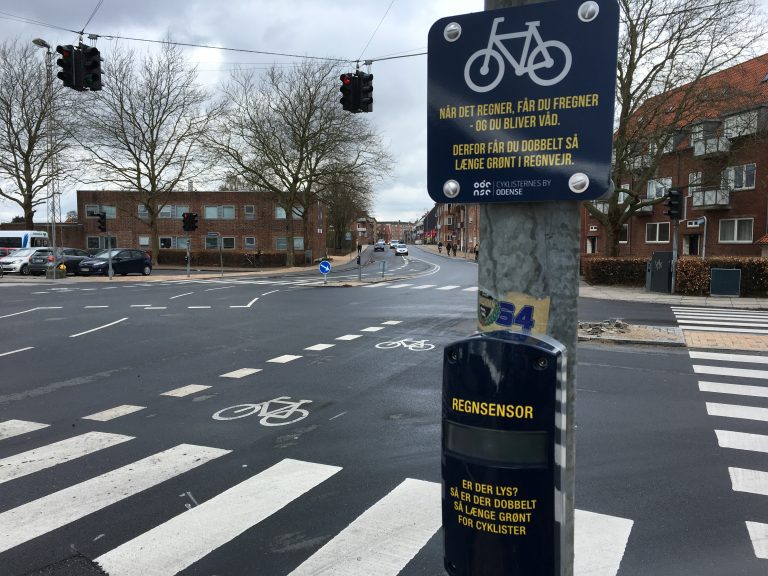
- Signs inform cyclists of the rain sensor’s function and a message- received light informs them when the function is activated. Photo. Odense municipality
Signal optimization and corridor management in Copenhagen
Today ITS makes it possible to control bicycle traffic on the corridor level without the cyclist having to alterbehaviour. In the City of Copenhagen an intelligent traffic control platform controls the city’s signals and ensures a dynamic prioritization of different types of road user according to the concrete traffic needs at a given time.
OnNørrefarimagsgade in Copenhagen, for example, cyclists are detected by ViSense cameras. If more than 300 cyclists are detected over a period of 15 minutes or if travel time on a stretch is longer than 2 minutes 30 seconds, the traffic control system gives cyclists a longer green phase.
Data from the camera can be used in different ways. Phase data from the signals and data from the cameras about the number of cyclists in a corridor can be used to calculate cyclist travel time and the data can be used to optimize signals and ensure that objectives for cyclist travel speed and flows are fulfilled.

- Photo Danish Cyclists’ Federation, Marie Hald
Making bicycle traffic visible
Many different ITS measures can make cycling more attractive. However, cyclists also need to be visibly shown that they are appreciated. Streets are typically designed for maximum comfort and accessibility for vehicular traffic, so it’s necessary to make it clearly visible to cyclists at the right places that they are an important priority and that cycling has many advantages. Here too ITS can prove useful.
Bicycle counters
Bicycle counters can be set up in urban spaces and several Danish cities have done it. A counter is set up showing cyclists how many cyclists have been counted that day over a given period, for example a month or a year. This is an easy way of showing cyclists that their bicycle trip literally counts. The counter can also be used to show other information such as the time and the temperature. At the same time the local authority gets an on-going bicycle count on a given stretch.
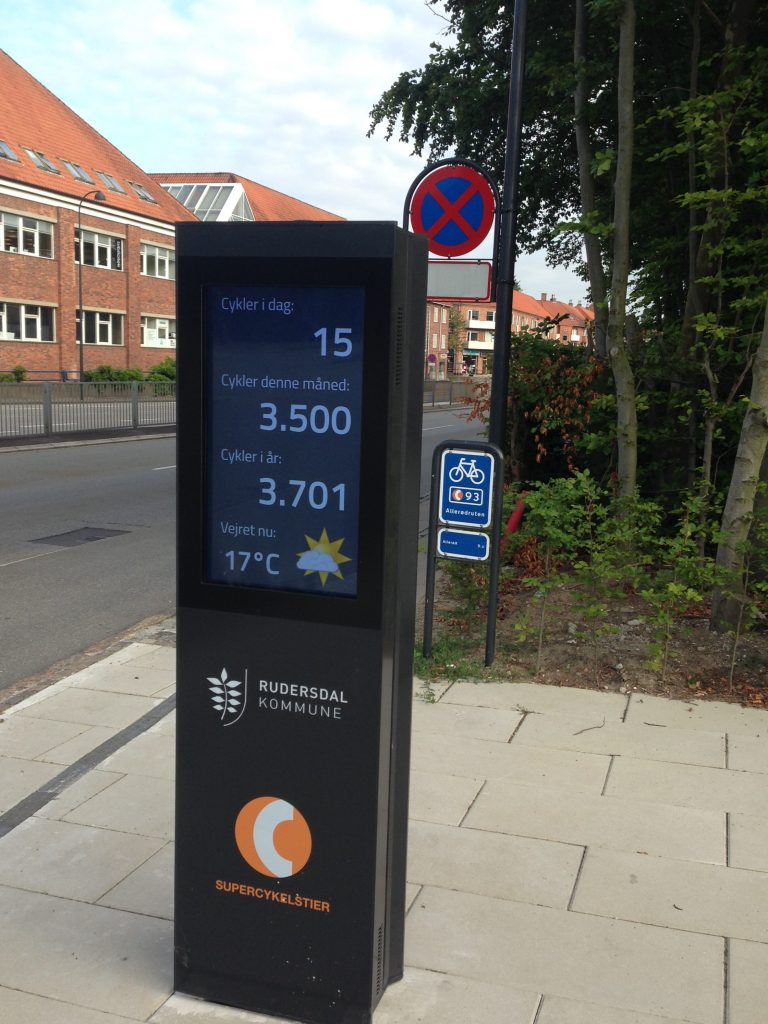
- The bicycle counter in Rudersdal municipality shows cyclists the day, month, year and weather. Photo. Cycle superhighways, capital region of Denmark
Det er ofte muligt at vise tællingerne på en hjemmeside, så det er muligt at holde øje med cykelbarometrene fra afstand. Dette er fx tilfældet i Esbjerg, Helsingør og Favrskov kommuner. Det gør det lettere at drifte barometrene og fx lave konkurrencer mellem forskellige byer eller bydele om, hvem der kan få flest cyklister forbi cykelbarometret inden for en bestemt periode.
Dynamic traffic information for cyclists
- Nørrebrogade near DronningLouises Bridge
- Åboulevarden/Gyldensløvsgade
- Amagerfælledvej/Amager Boulevard
- Amager Boulevard/Amagerbrogade
- Amagerbrogade/Vermlandsgade
The first five electronic message signs were set up in 2017 and an on-going development is planned with input from cyclists about the type of information they want to be shown on the signs, including:
- Congestion
- Roadworks
- Events
- Distances to destinations
- Safety tips
- Travel times
- Comparative travel times between cars and bicycles
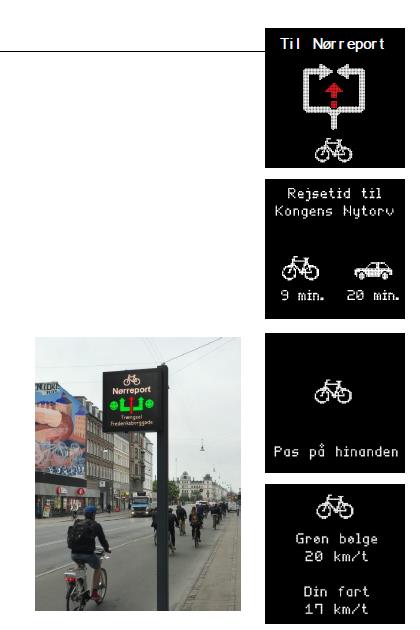
- Dynamic message signs for cyclists. Source: ITS for cyklister? Intelligent fremkommelighed og sikkerhed for cyklister. Programchef Mads Gaml, City of Copenhagen


